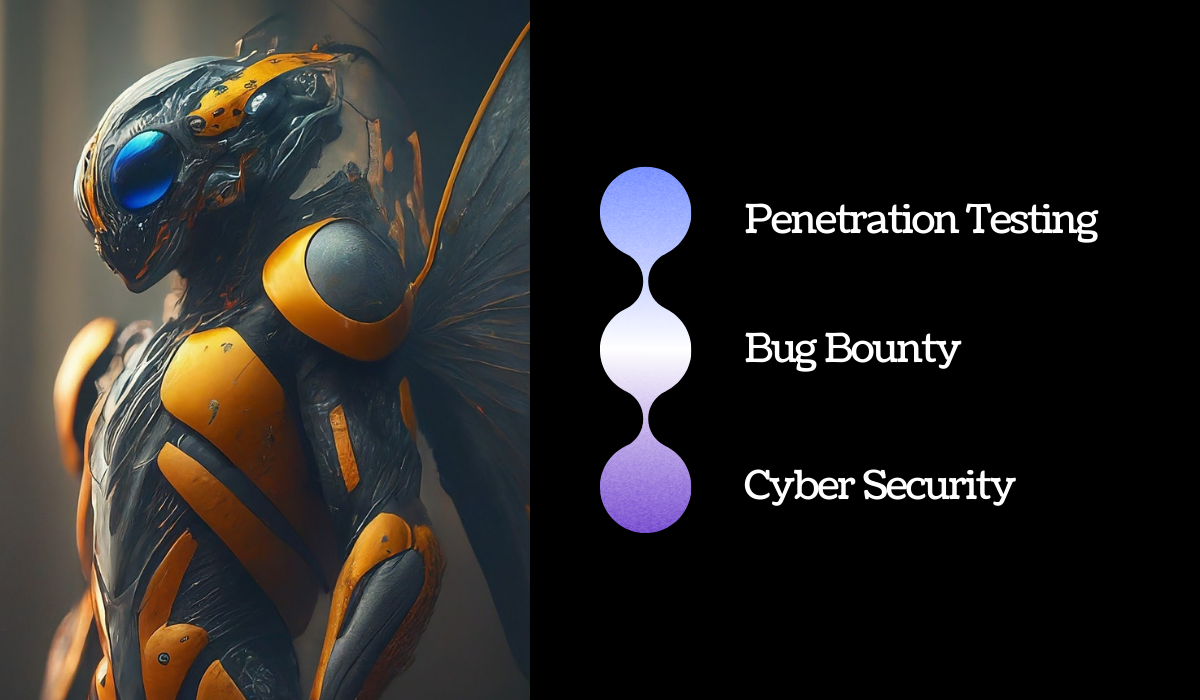Debunking the Difference: Penetration Testing vs. Bug Bounty

An overview of penetration testing and bug bounty programs by Devolity.
In the ever-evolving landscape of cybersecurity, organizations are constantly seeking ways to identify vulnerabilities in their systems and protect themselves from potential threats. Two popular methodologies that have emerged to address this concern are bug bounty programs and penetration testing. While both approaches aim to improve an organization’s security posture, they differ in their execution and scope. This article will delve into the distinctions between bug bounty and penetration testing, highlighting their benefits, drawbacks, and real-world applications.

A Comprehensive Overview of the Distinctions Between Penetration Testing and Bug Bounty by Devolity.
Finding weaknesses in a company’s systems is the aim of both penetration testing and bug bounty programs. Their techniques and methods, however, are very different. Through bug bounty programs, ethical hackers, also known as “white-hat hackers,” are enlisted to find and report vulnerabilities in exchange for cash payouts or recognition. Penetration testing, on the other hand, is a methodical and controlled procedure where security experts imitate actual attacks on an organization’s systems to find weaknesses.
The testing process’s control and scope are where the main differences are found. Through the use of the hacker community’s varied skill sets and collective intelligence, bug bounty programs expand the scope of testing. On the other hand, penetration testing is a targeted and controlled method that focuses on particular systems or components. A more comprehensive and in-depth evaluation of the targeted areas is provided by penetration testing, whereas bug bounty programs cover a larger ground.

Bug Bounty Programs: How They Work and Benefits
Bug bounty programs have grown in popularity in recent years because they are effective at identifying vulnerabilities that traditional security measures may have overlooked. These programs typically involve the creation of a public platform where ethical hackers can register, report vulnerabilities, and be rewarded based on the severity and impact of the issues discovered. Bug bounty programs provide several benefits:
- Bug bounty programs leverage the collective intelligence of a global community of ethical hackers, increasing the likelihood of identifying vulnerabilities that would otherwise go undetected.
- Bug bounty programs allow organizations to maintain an ongoing security testing process because they can be set to run indefinitely. This allows organizations to respond to emerging threats and vulnerabilities in real time.
- Cost-effectiveness: Bug bounty programs provide a cost-effective approach to security testing because organizations only pay for valid vulnerabilities discovered. This eliminates the need for full-time security professionals or outsourcing to specialized companies.
Penetration testing plays a critical role in cybersecurity.
While bug bounty programs cover a broader range of testing, penetration testing is critical for ensuring the security of specific systems and applications. Penetration testing simulates real-world attacks on an organization’s systems in order to identify vulnerabilities and assess the effectiveness of current security controls.
Penetration testing provides several benefits:
- Identifying specific vulnerabilities: penetration testing enables organizations to focus on specific systems or applications, resulting in a thorough assessment of their security posture. This allows organizations to prioritize remediation efforts and allocate resources more effectively.
- Penetration testing assists organizations in assessing the effectiveness of their current security controls and identifying any gaps or weaknesses. This allows for targeted enhancements to the overall security posture.
- Regulatory compliance: Many industries have mandated regular penetration testing. Penetration testing can help organizations ensure compliance with industry-specific regulations and standards.
Pros and Cons of Bug bounty and penetration testing.
Bug bounty programs and penetration testing have distinct advantages and disadvantages that organizations should weigh when determining the best approach for their security needs.
Advantages of Bug Bounty Programs:
- Utilizes the collective intelligence of ethical hackers. Bug bounty programs leverage the diverse skill sets and expertise of ethical hackers, increasing the likelihood of identifying vulnerabilities.
- Continuous security testing: Bug bounty programs offer an ongoing security testing process that is adaptable to new threats and vulnerabilities.
- Cost-effective: Bug bounty programs are a cost-effective approach to security testing because organizations only pay for valid vulnerabilities discovered.
The disadvantages of bug bounty programs include:
- Lack of control: Bug bounty programs rely on the hacker community and do not follow the controlled and targeted approach of penetration testing.
- Potential for false positives: Because bug bounty programs involve a large number of participants, there is a higher risk of receiving false positive reports, necessitating extra effort to verify their validity.
- Limited scope: While bug bounty programs offer broader coverage, they may not provide the same level of depth and specificity as penetration testing.
Disadvantages of penetration testing:
- Targeted approach: Penetration testing enables organizations to focus on specific systems or applications, providing a thorough evaluation of their security posture.
- Penetration testing assists organizations in assessing the effectiveness of their current security controls and identifying any gaps or weaknesses.
- Regulatory compliance: Penetration testing can help organizations meet industry-specific regulatory compliance requirements.
Cons of Penetration Testing:
- Limited coverage: Penetration testing focuses on specific systems or applications and may not provide the same breadth of coverage as bug bounty programs.
- Higher upfront cost: Penetration testing typically requires the involvement of specialized security professionals or external firms, resulting in higher upfront costs compared to bug bounty programs.
- Penetration testing is a time-consuming process that requires careful planning, execution, and analysis of results.
Factors to Consider When Choosing Between Bug Bounty and Penetration Testing
When choosing between bug bounty programs and penetration testing, organizations should consider several factors:
- Scope and coverage: Determine the desired scope and coverage for the security testing. Bug bounty programs have a broader scope, whereas penetration testing takes a more targeted approach.
- Budget and resources: Determine the available funds and resources for security testing. Bug bounty programs may be less expensive at first, whereas penetration testing requires a significant upfront investment.
- Control and reporting: Determine the level of control and reporting required. Bug bounty programs rely on a community of ethical hackers, whereas penetration testing offers a more controlled and documented process.
- Regulatory compliance: Determine whether industry-specific regulations require routine penetration testing.
Real-World Examples: Bug Bounty Success Stories.
Bug bounty programs have been instrumental in identifying critical vulnerabilities in various organizations, resulting in increased security. Some notable bug bounty success stories are:
- Facebook: In 2013, a hacker discovered a vulnerability that allowed unauthorized access to user accounts. Facebook responded by launching its bug bounty program, which has since identified numerous vulnerabilities and rewarded ethical hackers.
- Google: Google’s bug bounty program has discovered a number of vulnerabilities in their products and services, including a vulnerability in the Android operating system that allowed remote code execution.
- Tesla’s bug bounty program incentivizes ethical hackers to discover vulnerabilities in their vehicles’ software, resulting in critical security patches and improvements.
These Devolity success stories demonstrate how bug bounty programs can help organizations identify vulnerabilities and improve their security posture.
Common Issues in Bug Bounty and Penetration Testing.
While bug bounty programs and penetration testing provide significant benefits, they also present a number of challenges:
- Bug bounty programs necessitate effective communication and coordination between organizations and ethical hackers. Clear guidelines, reporting mechanisms, and bug triage processes are required for effective collaboration.
- False positives and false negatives: Both bug bounty programs and penetration testing can generate false positives and negatives. Organizations must set aside resources to validate and verify reported vulnerabilities.
- Limited expertise: In bug bounty programs, the expertise and skill sets of ethical hackers may differ, resulting in inconsistent results. Organizations may struggle to find and retain specialized security professionals for penetration testing.
Check the Google Bug Bounty Programs.
The Future of Bug Bounty And Penetration Testing.
As the Devolity cybersecurity landscape evolves, bug bounty programs and penetration testing will remain critical components of organizations’ security strategies. The future of bug bounty programs is likely to see increased automation and integration with existing security processes, allowing for real-time vulnerability identification and remediation. Penetration testing will continue to evolve as technology advances, adapting to new threats and assessing the effectiveness of new security controls.
The bottom line is: Bug bounty and penetration testing are complementary approaches to securing your systems.
In conclusion, bug bounty programs and penetration testing are complementary approaches to improving an organization’s security posture. Devolity Bug bounty programs use the collective intelligence of ethical hackers to provide a broader range of testing and continuous security assessment. Penetration testing, on the other hand, provides a targeted and controlled approach for evaluating specific systems and applications.
When deciding between bug bounty programs and penetration testing, organizations should consider a number of factors, including scope, budget, control, and regulatory compliance. Both methodologies have advantages and disadvantages, and the decision should be made based on the organization’s unique needs and requirements.
In today’s rapidly changing cybersecurity landscape, organizations that embrace bug bounty programs and penetration testing can proactively identify vulnerabilities, strengthen security measures, and stay ahead of potential threats.
CTA: To stay ahead of potential cybersecurity threats, implement a comprehensive security strategy that includes bug bounty programs and penetration testing. Contact us today to learn more about how we can help you secure your systems. Devolity program will help your business to keep it secure.
Transform Business with Cloud
Devolity simplifies state management with automation, strong security, and detailed auditing.







